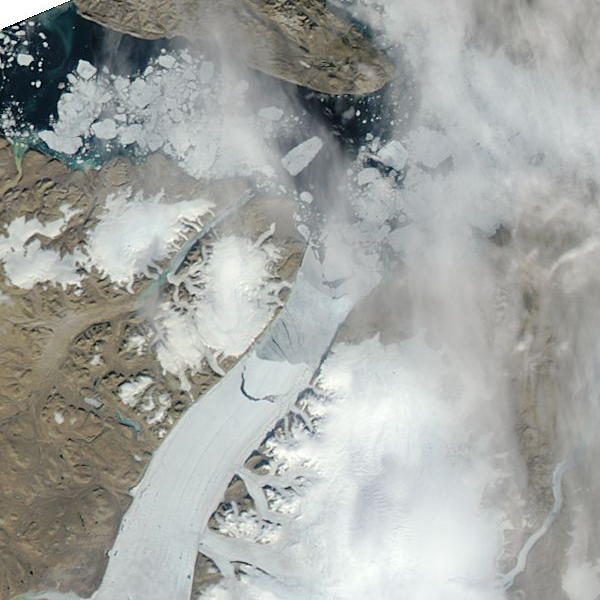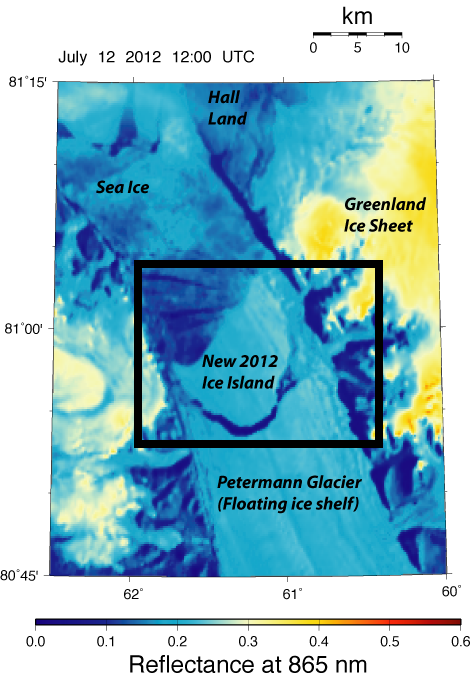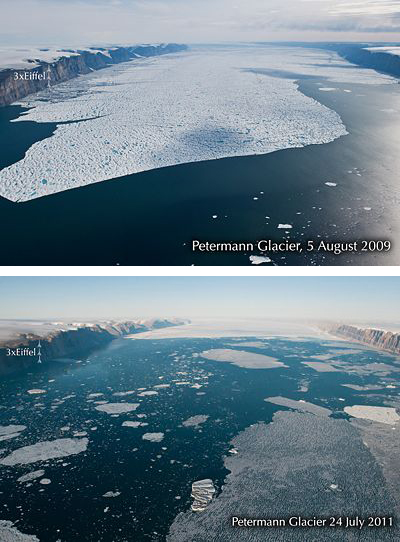Glacial Change Ain't What It Used To Be: Petermann Calves Another Huge Chunk of Greenland Ice

Petermann Glacier has calved another gigantic ice island, larger than twice the size of Manhattan, not quite as large as the calving of two years ago. A study this month found that the melting of the Greenland Ice Sheet is nearing a critical “tipping point.”
by Neven, via the Arctic Sea Ice Blog
This second big calving (spotted this time by Arcticicelost80) is another spectacular event on Greenland, after retreats of the Jakobshavn Glacier and lowest reflectivity of the Greenland ice sheet on record (see blog post), leading to unprecedented flooding in the southwest of Greenland.
From the Icy Seas blog:
This morning Petermann Glacier lost another ice island….

The break-off point has been visible for at least 8 years in MODIS imagery propagating at speeds of 1 km/year towards Nares Strait. The fracture also extended further across the floating ice sheet from the northern towards its southern side.
This event is still evolving, Trudy Wohleben of the Canadian Ice Service noticed it first (as in 2010) after reviewing MODIS imagery. Several people in several countries are monitoring and assessing the situation, but a first estimate of its size is 200 km^2 (3 Manhattans), I will revise this figure as soon as I got my hands on the raw data.
Two years ago Patrick Lockerby was the first to tell the world about the big calving that occurred at Petermann Glacier. The Arctic Sea Ice blog followed suit shortly afterwards. The whole event garnered a lot of attention, popularizing the island of Manhattan as an area measurement tool (metre, kilometre, Manhattan). This second big calving in as many years doesn’t come as a surprise, as attested by this article on the New York Times blog from August last year:
Thanks to satellites and other instruments, researchers do know what is happening to ocean and air temperatures in northwest Greenland. They have been warming briskly of late, as global-warming theory predicted decades ago that they would for the whole Arctic.
Dr. Box finds a drastic increase in sea-surface temperatures in the region, and a sharp decline in sea ice. Scientists suspect that warmer water is circulating under Greenland’s floating ice shelves and causing them to weaken. But given the dearth of measurements from beneath Petermann, they do not have hard proof that is what happened in this case.
The breakup of the Petermann ice shelf fits into a broader picture. Many lines of evidence suggest that melting and breakup of Greenland ice, a phenomenon once concentrated on the southern end of that island, has spread to the colder northwest corner. As I reported last year, many scientists are worried about the overall fate of the Greenland ice sheet, especially the prospect that its melting could raise global sea levels substantially.
Dr. Box said another chunk of the Petermann Glacier, this one about twice the size of Manhattan, is now on the verge of breaking loose.
Dr. Box was right. He can now add another image to these two he posted on the blog of the Byrd Polar Research Center blog last year:
In response to the question: How abnormal is this event? Jason notes: “The August 2010 ice calving at Petermann is the largest in the observational record for Greenland” Falkner et al. (2011) scoured the observations and found no evidence of an event this large in scattered observations since 1876. Johannessen et al. (2011) identified the next largest observed Petermann calving event ocurring in 1991, being 58% as large as the 2010 event.
Another image can be added to these two posted in the same BPRC blog post (check out the little Eiffel towers on the left that give an idea about this mamma’s magnitude):

When it comes to those “dearth of measurements” mentioned in the article, Andreas Münchow, a sea-going physical oceanographer from the University of Delaware, is supposed to go to Nares Strait (here to be precise) on the Canadian Coast Guard Ship Henry Larsen at the beginning of August to retrieve instruments that have recorded ocean current, temperature, salinity, and ice thickness data at better than hourly intervals from 2009 through 2012. As Dr. Münchow says in a comment following the blog post I alluded to at the top:
I am crunching numbers … this is a very worrisome event that will make our lives to get a ship recover our instrumentation more challenging and risky. I hope that this ice island will stay inside the fjord until we have safely entered and exited Nares Strait the first 2-3 weeks in August.
You can return to the main Market News page, or press the Back button on your browser.

